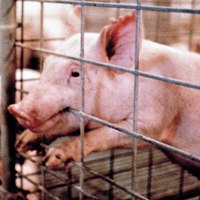EU: Concern about pig tail-biting

Increased tail-biting can be a result of poor living conditions for intensively farmed pigs, according to an EU animal health and welfare panel.
The European Food Safety Authority (EFSA) panel on Animal Health and Welfare says that the absence of straw, slatted floors and a barren environment can lead to the problem of tail-biting.
A review of European legislation on minimum standards for the protection of pigs has been published by the panel along with two recent reports on housing and husbandry practices for adult breeding boars, pregnant and farrowing sows and unweaned piglets, and fattening pigs.
The review follows a request by the Commission to assess the risks associated with tail-biting in pigs, and possible ways of reducing the need for tail-docking through different housing and husbandry systems.
Conclusions
The panel concluded that tail-docking can reduce the frequency of tail-biting under common intensive farming conditions, but does not completely eliminate the problem under unfavourable conditions.
More research is suggested to address the difference in the amount of tail-biting in docked and undocked pig populations in different housing systems, the severity and duration of chronic pain and the effect of genetic, environmental, age and sex differences on the occurrence of tail-biting.
Related website:
• EFSA











